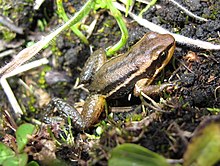
Gastrotheca is a genus of frogs in the family Hemiphractidae. They are found in Central America south of Costa Rica and in South America. Most species occur in the American Cordillera from southern Costa Rica to north-western Argentina. This genus makes up the bulk of marsupial frog diversity; formerly it was placed in the "Leptodactylidae" assemblage.

Centrolene is a genus of glass frogs in the family Centrolenidae. The adult males are characterized by having a humeral spine, as most members of this family. The delimitation of this genus versus Cochranella is not fully resolved, and some species formerly in Centrolenella — which is nowadays synonymized with Centrolene — are now in Hyalinobatrachium.
Colostethus is a genus of poison dart frogs native to Central and South America, from Panama south to Colombia, Ecuador, and northern Peru. Their common name is rocket frogs, but this name may refer to frogs in other genera and families, following the taxonomic revision of the genus in 2006.

Hyloscirtus is a genus of Neotropical frogs in the family Hylidae. This genus was resurrected in 2005 following a major revision of the Hylidae, with the distinguishing features being 56 transformations in nuclear and mitochondrial proteins and ribosomal genes. Of these species, 28 species, previously placed in the genus Hyla, were moved to this genus. The fingers and toes of these frogs have wide dermal fringes.

Allobates is a genus of frogs in the family Aromobatidae. They are native to the Central and South Americas, from Nicaragua to Bolivia and Brazil, with one species on Martinique.
Hyloxalus betancuri is a species of frogs in the family Dendrobatidae. It is endemic to Colombia where it is only known from its type locality in Ituango, Antioquia Department, on the Cordillera Occidental at 1,450 m (4,760 ft) asl. Its natural habitats are sub-Andean forests where it can be found on the ground next to streams. There are no known threats to this species, and the type locality is within the Parque Nacional Natural Paramillo.
Hyloxalus bocagei is a species of frog in the family Dendrobatidae. It is found on the northeastern side of the Andes in Ecuador and in Colombia. The specific name bocagei honors José Vicente Barbosa du Bocage, a Portuguese zoologist. Common name Bocage's rocket frog has been coined for this species.
Hyloxalus borjai is a species of frog in the family Dendrobatidae. It is endemic to Colombia and only known from its type locality, Amalfi, Antioquia, on the Cordillera Central at 1,575 m (5,167 ft) asl. Its natural habitats are sub-Andean forests. Very little is known about this species.
Hyloxalus breviquartus is a species of frog in the family Dendrobatidae. It is found in the northern part of Cordillera Occidental in Antioquia, Colombia, and in Carchi Province in northwestern Ecuador. Colombian distribution may be wider. Its natural habitats are montane forests next to streams and very humid premontane forests. It is threatened by habitat loss, although it occurs in the Las Orquídeas National Natural Park, its type locality.
Hyloxalus exasperatus is a species of frog in the family Dendrobatidae. It is endemic to Ecuador and found on the eastern slopes of the Andes in Pastaza and Morona-Santiago Provinces. However, it is suggested that specimens from Pastaza represent a different, possibly undescribed species.
Hyloxalus excisus is a species of frog in the family Dendrobatidae. It is endemic to Colombia. It is only known from its type locality near Medellín, Antioquia Department, on the Cordillera Central.

Leucostethus fraterdanieli is a species of frog in the family Dendrobatidae. It is endemic to the Andes in Colombia. Colostethus yaguara might be its junior synonym. It lives on the ground close to streams in cloud forests and in dry tropical forests. It is threatened by habitat loss caused by agriculture and logging.
Hyloxalus fuliginosus is a species of frog in the family Dendrobatidae. It may be endemic to Ecuador where it is known from the Amazonian slopes of the Andes in the northern Ecuador, with some sources reporting it from Colombia and Venezuela.
Hyloxalus lehmanni is a species of frog in the family Dendrobatidae. It is found widely in Colombia from Antioquia southwards to northern Ecuador.
Hyloxalus picachos is a species of frog in the family Dendrobatidae. It is endemic to Colombia where it is only known from its type locality in the Parque Nacional Cordillera los Picachos, Cordillera Oriental of Caquetá Department. Its natural habitat is montane humid forest where it lives on the forest floor.
Hyloxalus pulchellus is a species of frog in the family Dendrobatidae from northern Ecuador and southern Colombia. Colombina source does not include Nariño but does include Putumayo Department.
Hyloxalus saltuarius is a species of frogs in the family Dendrobatidae. It is endemic to Colombia where it is only known from the Cordillera Oriental in the Caquetá Department. Its natural habitats are premontane humid forests. It lives on the forest floor.
Hyloxalus sauli is a species of frogs in the family Dendrobatidae. It is found on the eastern Andean slopes in Putumayo, Colombia, and in Sucumbíos, Napo, Orellana, and Pastaza Provinces, Ecuador. It is named after William Saul from the University of Kansas Natural History Museum.
Pristimantis polemistes is a species of frogs in the family Strabomantidae. It is endemic to Colombia and only known from the vicinity of its type locality in Urrao, Antioquia Department, on the western flank of the Cordillera Occidental. The specific name polemistes is Greek for "warrior" and refers to the insurgents that operated in the area of the type locality.






